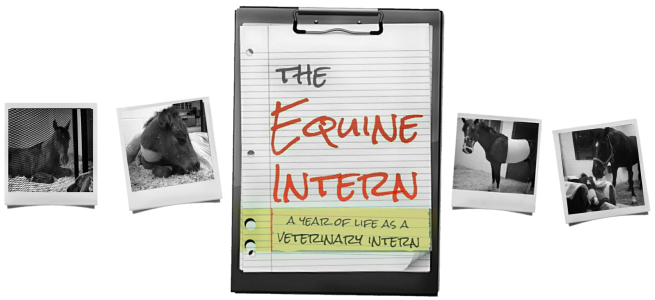
It is official, that 6 weeks into the internship, I’ve received the stamp of approval to run anesthesia solo. 11 anesthesia cases, over 50 hours logged behind the anesthesia wheel, and now it’s time to pilot alone. Not sure what the deal is with all the aviation jargon… but finally, accomplished the anesthesia training goal. Not that the learning stops here, as most of my surgeries are elective orthopedic surgeries. I’ve only done 3 colics that were pretty systemically stable. No dystocias, no foals, certainly no colon torsion. Help resides on the other side of the blue drapes now, and I know at any time I can seek assistance from the residents or surgeons, but still.
Before all of the training, my equine anesthesia comfort level was a miserable 0%. My real-time comfort level is significantly improved, usually sitting around 80%….the remaining 20% out of reach because of the absolute fear that at any moment, the patient could crash. And while I have my occasional Art-line impossible moments, for the most part I’ve worked out the kinks and fallen into a routine.
DEVELOPING A ROUTINE
For 99% of my cases, my anesthesia pre-medications include Xylazine and Butorphanol. For the average horse, I like to do half the 10 mg butorphanol dose as a pre-med, and the second half in surgery. After the patient is hooked up to the anesthesia machine and monitoring equipment set-up, there is roughly 20 minutes of wait time while the surgeons scrub and gown. My second dose of Butorphanol is therefore given about 15 minutes prior to the start of surgery (first incision).
I usually hang a 5 liter plasmalyte bag and run the fluids full-speed throughout the entire procedure. 90% of the my anesthesia cases receive a lidocaine CRI, unless the surgery time will be less than 45 minutes…since Lidocaine CRIs need to be stopped 20-30 minutes prior to the end of anesthesia. If the patient happens to develop rapid nystagmus or moves, I use a ketamine “bump” of 300 mg IV to get them quiet while other anesthesia changes are being adjusted (ISO, or addition of another CRI). Knock on wood, I have yet to have a crashing patient or severe anesthetic crisis. The most common issue I face running anesthesia is hypotension (<70 mmHg), usually corrected with a multifaceted approach that involves decreasing ISO and starting a slow drip Dobutamine CRI. 
Recoveries are almost always done with rope assistance, and I’ve only done 3 hand-recoveries. For recovery, I like to use 1/3 of my Xylazine pre-med dose and half of an average horse dose of Romifidine (usually 4 or 5 mg IV). I’ve had the best recoveries with this protocol. The patient is in lateral for 30 minutes (and I mean this is pretty spot on 30 minutes), and with 1-2 attempts the horse stands with minimal rope support. The Romifidine has less of an ataxic effect, the I don’t see the same paresis, trembling and in coordinate that I do when using Xylazine alone. The routine elective orthopedic surgeries average a 45 minute recovery, which is timed from the moment the horse arrives in the recovery stall to the moment the horse walks out of the recovery stall. Depending on anesthesia time, depth and systemic condition, recoveries have taken anywhere from 15 minutes to 3 hours.
The last phase of anesthesia involves record submission, drug log maintenance, induction and Recovery stall cleaning/disinfecting, cleaning/restocking equipment and supplies, and basic anesthesia set-up for the next surgery. All in all, this takes anywhere from 1-3 hours.
THE REAL REWARD

More exciting than the anesthesia thumbs-up and the training accomplishment, is what comes next. Having graduated from the basic intern anesthesia training program, I now get to advance to the real services…Medicine and surgery.
I will spend the next two weeks in the medicine service department, while running anesthesia on the side (during normal hours and on call). I have been anxiously awaiting to joint a service, see appointments, take on some patients…so, I was a little disappointed to discover that there are no medicine appointments for the remainder of the week. None. As of today, not a single appointment or consultation. And patients to be transferred to my care? None. As of today, not a single one.
Still, despite the empty schedule and inpatient caseload, I could not possibly be more excited to venture into a new realm in this year-long equine internship. Appointments, patients…come what may!
#ANESTHESIA #VETERINARY #INTERNSHIP #EQUINE #VETINTERN



